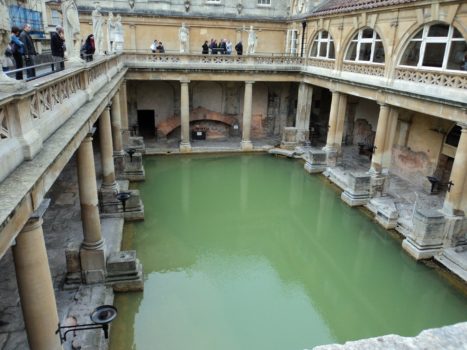
A Brief History of The Roman Baths
A spa break in Bath is truly incomplete without a trip to the Roman Baths. Although you won’t be allowed to bathe there-the place for soaking up the mineral rich waters is at the Thermae Spa. But, you will be able to see the ruins up-close during your walk-through excursion. The Roman Baths are a sacred Roman site that has been unbelievably well maintained for public viewing and tours.
The Natural Hot Waters
When the waters were first discovered, the ancients were perplexed, and unable to understand how this hot water could possibly materialize from the ground in seemingly endless supply. So they, of course, attributed the bubbling thermal waters to wizardry of the gods.
What really happens is this: Rainwater falling in the Mendip Hills collects and trickles down through limestone rock and other rocky materials to depths of up to 2 1/2 miles, where energy from the earth’s core heats the waters and creates pressure, pushing the water to the surface. On a daily basis, over one million liters of the heated water then rises at about 46 degrees Celsius (144 degrees Fahrenheit) up to an area that forms the springs.
Legend Has It…Miracle Waters
Around 863 BC, Prince Bladud, suffering from leprosy, noticed that pigs who wallowed in the spring waters and surrounding mud were cured of their skin ailments, so he began wallowing in the mud. Lo and behold, the natural hot spring waters cured his disease. The spring that supplies the site of the Roman Bath is called King’s Spring, after Bladud, who was later crowned the ninth King of the Briton’s.
Two additional springs run below the city; the Cross and the Hetling Springs. These springs supply the fantastic new Thermae Bath Spa, where you can indulge in a variety of spa treatments, or just take a soak in the restorative waters.
The Celts and The Romans
The Celts were the first to build a shrine to their goddess Sulis. In approximately AD 43, the Romans built Aquae Sulis, in reverence to their goddess, Minerva and in recognition of the Celt’s Sulis.
During that time, most Roman settlements were garrisons, but Aquae Sulis was quite different. It was deemed a place for rest and relaxation. Construction of this elaborate sanctuary continued for over 300 years, and included lead piping and sophisticated heating sources that still stand today. The baths became not only a place for hygiene, but more of a social scene. The baths were operated by the government and were affordable to the affluent as well as the working class. The Roman Baths were operated here until the Romans withdrew in 410 AD. After that the buildings fell into a state of disrepair.
Restoration of the Roman Baths
Several modifications have been made to the baths; in the 12th, 16th and 18th centuries. The King’s spring is now in an 18th century building, designed by John the Elder, who also designed The Circus.
What to Expect When Visiting the Roman Baths
If you are interested in seeing the best preserved Roman spas, Bath is the obvious place to come. But what exactly can you expect to see when you visit this world-famous historical site? Well, if you join one of the regular tours that are held throughout the course of each day, you can look forward to seeing all of the following magnificent sights:
- Victorian Reception Hall – The tour starts in the magnificent Victorian reception hall, which boasts a beautifully decorated dome ceiling.
- The Great Bath Terrace – The terrace offers fantastic views of the Great Bath below.
- Scale Models of the Temple and Baths Complex – The scale models of the complex help you to visualise what it was like in Roman times.
- The Temple Pediment – The stunning Temple pediment marks the spot where the statue of Sulis Minerva was once housed.
- Display of Archaeological Finds From the Site – In this section of the museum can be found artefacts illustrating local life and Roman worship customs.
- Temple Courtyard – From the suspended walkway above the courtyard, you can see where worshippers gathered some 2,000 years ago.
- Sacred Spring – The Sacred Spring is where the 46 °C mineral water still bubbles up from deep underground.
- Great Bath – This huge, lead-lined pool was the centre of the bathing activities here in Roman times.
- Changing Rooms and Saunas – This is the area of the complex where Roman visitors used to enjoy a sauna and get changed.
- Heated Rooms and Plunge Pools – Romans used to finish their bathing by making their way through the heated rooms and taking a dip in the large, circular, and very cold, plunge pool.
- Spa Water Fountain – Before leaving, don’t forget to taste the spa water at the fountain!
Having finished your tour, you can either take a leisurely stroll back to the Royal Hotel, which is just under half a mile away, or continue with your adventures in the city by visiting some of the other beautiful sites that Bath has to offer.
